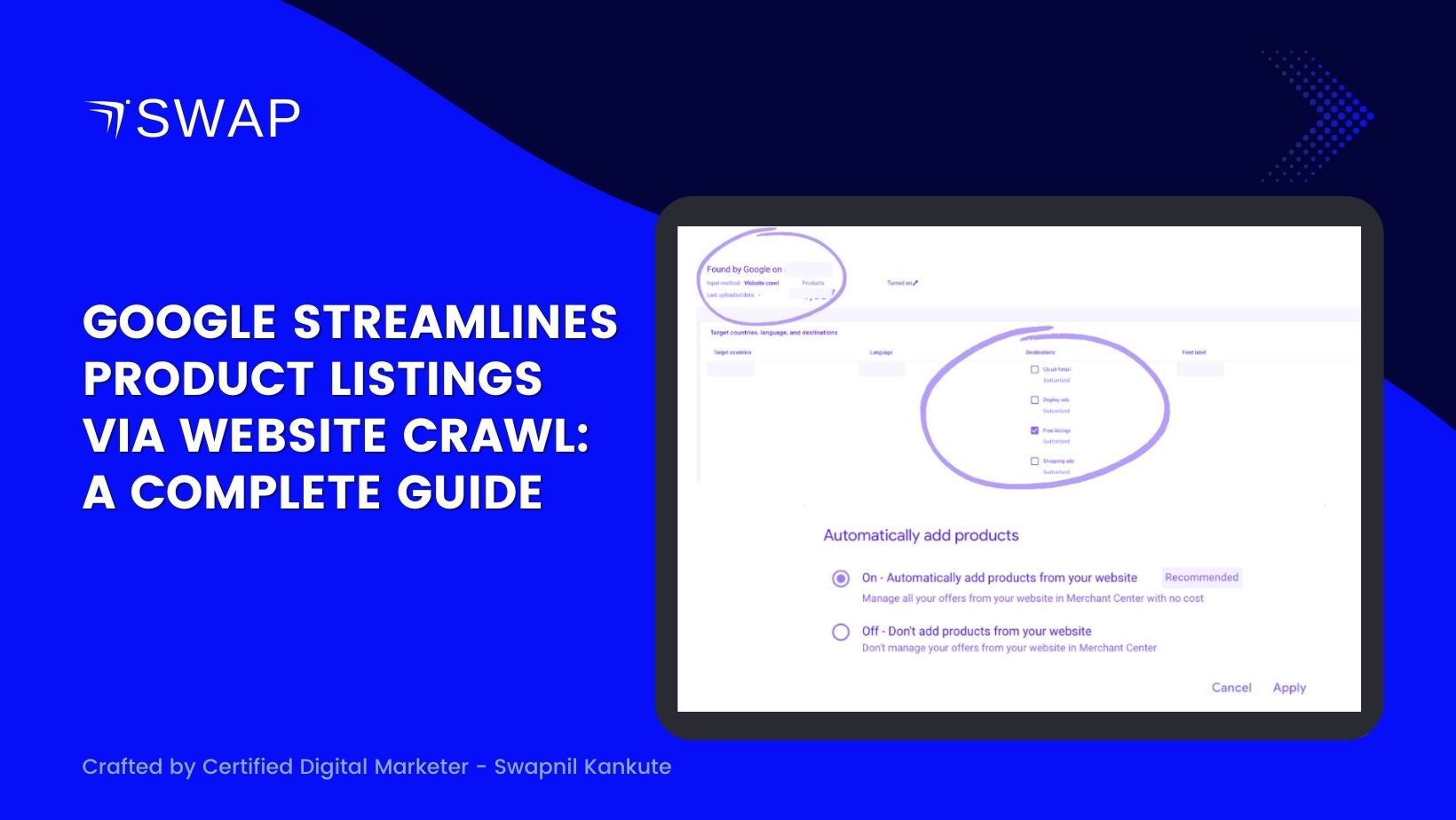Table of Contents
ToggleMeet Swapnil Kankute: Your Trusted Certified Digital Marketer in India
Hello, I’m Swapnil Kankute, a certified digital marketer in India with over 11 years of experience. Specializing in growth hacking and business development, I’ve helped businesses of all sizes achieve their marketing goals. Certified by Google, SEMrush, and Great Learning, I bring expertise in leveraging digital strategies to maximize online presence and growth. If you’re seeking to expand your business online, I’m here to assist you every step of the way.
Understanding Google’s Latest Innovation in Product Listings
Google’s Latest Advancement: Website Crawl Feeds for Product Listings
In today’s competitive digital landscape, effective product listing management is pivotal for online merchants. Google has introduced a revolutionary method through automated website crawl feeds to streamline this process, ensuring seamless integration and real-time updates across its platforms.
What is Google’s Website Crawl for Product Listings?
Exploring Google’s Innovative Approach: Website Crawl for Enhanced Product Integration
Google’s website crawl for product listings involves the automated extraction of structured data markup from merchant websites. This automated process allows Google to retrieve up-to-date information such as product titles, pricing, availability, and images directly from the source, eliminating the need for manual updates.
Simplifying Product Data Integration
Efficient Integration Made Easy: Benefits of Google’s Automated Website Crawl Feeds
By automating the extraction of product information, Google simplifies the task of updating product listings. This automation addresses common challenges associated with traditional methods, such as delays and inaccuracies in manual data uploads.
How Does Google’s Website Crawl Work?
Unveiling the Mechanism: How Google’s Website Crawl Enhances Product Listing Management
Google’s website crawl operates by scanning merchant websites that have implemented schema.org structured data markup. This markup guides Google in dynamically extracting essential product details, ensuring accuracy and timeliness in product updates.
Automating Product Listing Updates
Real-Time Updates: The Power of Automated Product Listing Management
Integrated website crawls continuously monitor changes on merchant websites. This includes additions, modifications, or removals of products, ensuring that the product inventory on Google’s Merchant Center remains current and precise.
Utilizing Structured Data Markup
Key to Efficiency: Leveraging Schema.org Markup for Seamless Data Extraction
Structured data markup plays a crucial role in facilitating automated product updates. Merchants must implement markup for critical attributes like title, price, availability, and images to enable smooth data extraction by Google.
Extracting Information Dynamically
Dynamic Extraction: Ensuring Accurate and Current Product Listings
The dynamic extraction process ensures that Google presents the most up-to-date product listings across its platforms. This enhances visibility and accessibility for potential customers, driving engagement and conversions.
The Significance of Automated Feeds
Embracing Efficiency: Why Automated Website Crawl Feeds Matter
Automated website crawl feeds mark a significant advancement in product data management. By minimizing manual intervention, businesses can focus more on strategic growth initiatives rather than routine maintenance tasks.
Reducing Manual Effort in Product Updates
Efficiency Unleashed: Benefits of Minimized Manual Data Entry
Automating product listing updates reduces the time and resources spent on manual data entry and verification. This efficiency empowers marketing teams to allocate resources towards optimizing campaigns and enhancing customer experiences.
Challenges with Traditional Methods
Overcoming Obstacles: Issues with Traditional Product Listing Updates
Traditional methods relying on periodic uploads of data files often lead to errors and delays. Google’s automated feeds mitigate these challenges by ensuring that product information reflects real-time changes on merchant websites.
Benefits of Automated Crawling
Driving Business Growth: Enhanced Benefits of Automated Product Data Synchronization
Automated crawling ensures that product listings are synchronized with website updates automatically. This seamless integration improves data accuracy and customer satisfaction, ultimately boosting conversion rates.
Implementing Schema.org Markup for Product Details
Essential Elements: Key Aspects of Implementing Schema.org Markup
Successful integration of schema.org markup is essential for optimizing automated website crawl feeds. Critical elements include:
Key Elements for Successful Integration
- Title: Clearly defining product names.
- Price: Specifying current pricing information.
- Availability: Indicating product stock status.
- Image: Providing high-quality product visuals.
- Enriching Listings with Additional Attributes: Including GTIN, brand, size, and condition enhances product information.
Exploring the New “Website” Feed Experience
Enhanced User Experience: Google’s Innovative “Website” Feed Interface
Google’s introduction of the “Website” feed interface offers a user-friendly solution for managing automated product ingestion, enhancing operational efficiency for merchants.
Streamlined Integration for Merchants
Simplified Management: Toggling Automated Product Ingestion On/Off
Merchants can easily manage automated product ingestion settings within the Merchant Center interface, optimizing data feed management.
Toggle Product Ingestion On/Off
Flexible Control: Managing Product Ingestion Settings Effectively
Control over product ingestion settings allows merchants to synchronize updates with Google’s platforms according to business needs, ensuring timely and accurate product listings.
Automatic Addition and Removal of Products
Effortless Inventory Management: Automated Product Addition and Removal
Products are automatically added or removed from the Merchant Center based on updates detected during website crawls, maintaining precise inventory control.
Integration with Existing Data Sources
Unified Data Management: Seamless Integration with Existing Data Feeds
Automated website crawl feeds complement existing data sources without duplication, ensuring consistent and reliable product information across all platforms.
Complementing Without Duplication
Enhanced Efficiency: Avoiding Redundancy in Data Management
Integration with existing data feeds enhances operational efficiency by avoiding duplication in data management efforts.
Ensuring Data Consistency
Maintaining Accuracy: Best Practices for Consistent Data Management
Consistent management of crawl directives via sitemaps and robots.txt is crucial to prevent indexing issues and maintain data integrity across Google’s platforms.
Challenges and Best Practices
Optimizing Performance: Addressing Challenges and Implementing Best Practices
Successful implementation and management of automated website crawl feeds require adherence to best practices to maximize effectiveness.
Implementing Structured Data Correctly
Foundation for Success: Importance of Accurate Structured Data Implementation
Accurate implementation of structured data ensures effective data extraction by Google’s automated processes, enhancing overall performance.
Managing Crawl Directives Effectively
Controlling Indexing: Utilizing Sitemaps and Robots.txt for Optimal Crawl Management
Effective management of crawl directives optimizes which website content Google indexes during crawls, ensuring comprehensive coverage.
Avoiding Indexing Issues
Proactive Measures: Preventing Common Indexing Challenges
Proactively addressing indexing issues like duplicate content minimizes discrepancies in product listings, optimizing search engine visibility.
Insights from Google
Expert Guidance: Leveraging Supplemental Feeds for Enhanced Product Information
According to Google’s automated feed documentation, supplemental feeds offer additional capabilities for enriching product information and facilitating more frequent updates.
Strategic Implications of Automated Feeds
Strategic Advantage: Aligning with Google’s AI-First Strategy
Google’s adoption of automated feeds aligns with its AI-first strategy, emphasizing structured data as foundational for enhancing user experience and accuracy.
Aligning with Google’s AI-First Strategy
Enhanced Performance: Leveraging Automated Data Extraction for Improved User Experience
Prioritizing automated data extraction enhances Google’s ability to deliver relevant product information effectively, boosting user engagement and satisfaction.
Impact on SEO and Marketing Efforts
Driving Business Growth: Enhancing SEO and Marketing Campaigns
Automated website crawl feeds enhance SEO efforts by improving product visibility in search results. This visibility drives targeted traffic and enhances conversion rates, maximizing business growth.
Conclusion
Embracing Efficiency in Product Management
Google’s automated website crawl feeds represent a significant advancement in simplifying product data management for online merchants. By leveraging structured data and automated extraction processes, businesses can streamline product listing updates, reduce manual effort, and enhance data accuracy across Google’s platforms.
Sources:
- LinkedIn – Google Product Listings Website Crawl
- Search Engine Land – Google Product Listings Website Crawl



